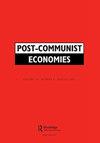Estimation of a small open economy DSGE model for Kazakhstan
IF 1.8
3区 经济学
Q2 ECONOMICS
引用次数: 2
Abstract
ABSTRACT This paper adapts and estimates the DSGE model of Medina and Soto (2007) in the context of Kazakhstani economy. The main goal of the paper is to contribute to the scarce macroeconomic modelling literature on Kazakhstan and analyse the structure of the Kazakhstani economy using the DSGE framework. Overall, we find that the oil price shock is key in explaining the variance of virtually all the variables of interest – in particular, it accounts for more than 40% of variance in real exchange rate over the long-term horizon. Furthermore, while the oil price and commodity (oil) production shocks contributed positively to the country’s GDP growth in real terms before the Great Recession, their effects have been primarily negative during the two major economic crises of 2007 and 2015, and the fiscal policy has had mixed success in counteracting them. Lastly, the counterfactual exercises show that the choice to adopt the floating exchange rate policy in 2015 has prevented a larger output slump in the short-term at the cost of stronger currency depreciation, and that countercyclical fiscal rules would have greatly mitigated the immediate negative impact of the 2007–08 and 2015 crises, in addition to making real output more stable overall.哈萨克斯坦小型开放经济体DSGE模型的估计
摘要本文在哈萨克斯坦经济背景下,对Medina和Soto(2007)的DSGE模型进行了调整和估计。本文的主要目标是为稀少的哈萨克斯坦宏观经济建模文献做出贡献,并使用DSGE框架分析哈萨克斯坦经济结构。总的来说,我们发现油价冲击是解释几乎所有利率变量方差的关键——特别是,它占长期实际汇率方差的40%以上。此外,尽管油价和大宗商品(石油)生产冲击在大衰退前对该国的实际GDP增长做出了积极贡献,但在2007年和2015年的两次重大经济危机期间,其影响主要是负面的,财政政策在应对这些影响方面取得了喜忧参半的成功。最后,反事实演习表明,2015年采取浮动汇率政策的选择避免了以货币贬值为代价的短期内更大的产出下滑,反周期财政规则除了使实际产出总体更加稳定外,还将大大减轻2007-2008年和2015年危机的直接负面影响。
本文章由计算机程序翻译,如有差异,请以英文原文为准。
求助全文
约1分钟内获得全文
求助全文
来源期刊

Post-Communist Economies
ECONOMICS-
CiteScore
4.90
自引率
18.20%
发文量
21
期刊介绍:
Post-Communist Economies publishes key research and policy articles in the analysis of post-communist economies. The basic transformation in the past two decades through stabilisation, liberalisation and privatisation has been completed in virtually all of the former communist countries, but despite the dramatic changes that have taken place, the post-communist economies still form a clearly identifiable group, distinguished by the impact of the years of communist rule. Post-communist economies still present distinctive problems that make them a particular focus of research.
 求助内容:
求助内容: 应助结果提醒方式:
应助结果提醒方式:


